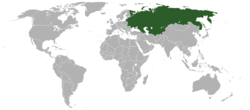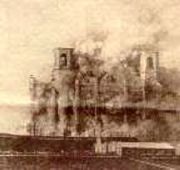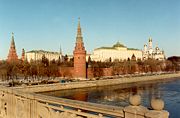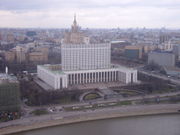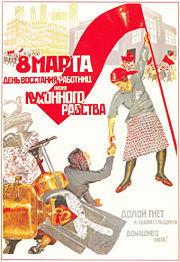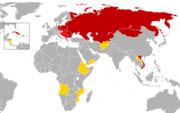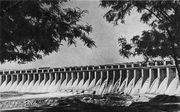Soviet Union
2008/9 Schools Wikipedia Selection. Related subjects: Recent History
|
|||||||||||||||||||||||||||||||||||||||||||||||||||||||||||||||||||||||||||||||||||||||||||||||||||||||||||||||||
The Union of Soviet Socialist Republics ( abbreviated USSR, Russian: Союз Советских Социалистических Республик, СССР; tr.: Soyuz Sovetskikh Sotsialisticheskikh Respublik, SSSR), also called the Soviet Union (Russian: Советский Союз; tr.: Sovetsky Soyuz), was a constitutionally socialist state that existed in Eurasia from 1922 to 1991.
Emerging from the Russian Empire following the Russian Revolution of 1917 and the Russian Civil War of 1918–1921, the USSR was a union of several Soviet republics, but the synecdoche Russia—after its largest and dominant constituent state—continued to be commonly used throughout the state's existence. The geographic boundaries of the USSR varied with time, but after the last major territorial annexations of the Baltic states, eastern Poland, Bessarabia, and certain other territories during World War II, from 1945 until dissolution the boundaries approximately corresponded to those of late Imperial Russia, with the notable exclusions of Poland, most of Finland, and Alaska. The Soviet Union became the primary model for future Communist states during the Cold War; the government and the political organization of the country were defined by the only political party, the Communist Party of the Soviet Union.
From 1945 until dissolution in 1991—a period known as the Cold War—the Soviet Union and the United States of America were the two world superpowers that dominated the global agenda of economic policy, foreign affairs, military operations, cultural exchange, scientific advancements including the pioneering of space exploration, and sports (including the Olympic Games and various world championships).
Initially established as a union of four Soviet Socialist Republics, the USSR grew to contain 15 constituent or "union republics" by 1956: Armenian SSR, Azerbaijan SSR, Byelorussian SSR, Estonian SSR, Georgian SSR, Kazakh SSR, Kirghiz SSR, Latvian SSR, Lithuanian SSR, Moldavian SSR, Russian SFSR, Tajik SSR, Turkmen SSR, Ukrainian SSR, and Uzbek SSR. (From annexation of the Estonian SSR on August 6, 1940 up to the reorganisation of the Karelo-Finnish SSR into the Karelian ASSR on July 16, 1956, the count of "union republics" was 16.)
History
The Soviet Union is traditionally considered to be the successor of the Russian Empire and of its short-lived successor Provisional Government under Georgy Yevgenyevich Lvov and then Alexander Kerensky. The last Russian Tsar, Nicholas II, ruled until March, 1917 when the Empire was overthrown and a short-lived Russian provisional government took power, the latter to be overthrown in November 1917 by Vladimir Lenin. From 1917 to 1922, the predecessor to the Soviet Union was the Russian Soviet Federative Socialist Republic (RSFSR), which was an independent country as well as other Soviet republics at the time. The Soviet Union was officially established in December 1922 as the union of the Russian (colloquially known as Bolshevist Russia), Ukrainian, Belarusian, and Transcaucasian Soviet republics ruled by Bolshevik parties.
Revolution and the foundation of a Soviet state
Modern revolutionary activity in the Russian Empire began with the Decembrist Revolt of 1825, and although serfdom was abolished in 1861, its abolition was achieved on terms unfavorable to the peasants and served to encourage revolutionaries. A parliament—the State Duma—was established in 1906 after the Russian Revolution of 1905, but the Tzar resisted attempts to move from absolute to constitutional monarchy. Social unrest continued and was aggravated during World War I by military defeat and food shortages in major cities.
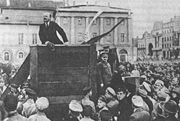
A spontaneous popular uprising in Petrograd, in response to the wartime decay of Russia's economy and morale, culminated in the toppling of the imperial government in March 1917 (see February Revolution). The tsarist autocracy was replaced by the Russian Provisional Government, whose leaders intended to establish liberal democracy in Russia and to continue participating on the side of the Entente in World War I. At the same time, to ensure the rights of the working class, workers' councils, known as soviets, sprang up across the country. The Bolsheviks, led by Vladimir Lenin, pushed for socialist revolution in the soviets and on the streets. They seized power from the Provisional Government in November 1917 (see October Revolution). Only after the long and bloody Russian Civil War of 1918–1921, which included foreign intervention in several parts of Russia, was the new Soviet power secure. In a related conflict with Poland, the " Peace of Riga" in early 1921 split disputed territories in Belarus and Ukraine between Poland and Soviet Russia.
Unification of the Soviet Republics
On December 28, 1922 a conference of plenipotentiary delegations from the RSFSR, the Transcaucasian SFSR, the Ukrainian SSR and the Byelorussian SSR approved the Treaty of Creation of the USSR and the Declaration of the Creation of the USSR, forming the Union of Soviet Socialist Republics. These two documents were confirmed by the 1st Congress of Soviets of the USSR and signed by heads of delegations - Mikhail Kalinin, Mikha Tskhakaya, Mikhail Frunze and Grigory Petrovsky, Aleksandr Chervyakov respectively on December 30, 1922. The first foreign state to recognize the Soviet Union was the Irish Republic. On February 1, 1924 the USSR was recognized by the British Empire.
The intensive restructuring of the economy, industry and politics of the country began in the early days of Soviet power in 1917. A large part of this was performed according to Bolshevik Initial Decrees, documents of the Soviet government, signed by Vladimir Lenin. One of the most prominent breakthroughs was the GOELRO plan, that envisioned a major restructuring of the Soviet economy based on total electrification of the country. The Plan was developed in 1920 and covered a ten to 15 year period. It included construction of a network of 30 regional power plants, including ten large hydroelectric power plants, and numerous electric-powered large industrial enterprises. The Plan became the prototype for subsequent Five-Year Plans and was basically fulfilled by 1931.
Stalin's rule
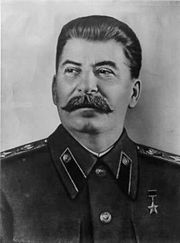
From its beginning years, government in the Soviet Union was based on the one-party rule of the Communist Party (Bolsheviks). After the economic policy of War Communism during the Civil War, the Soviet government permitted some private enterprise to coexist with nationalized industry in the 1920s and total food requisition in the countryside was replaced by a food tax (see New Economic Policy). Soviet leaders argued that one party rule was necessary because it ensured that 'capitalist exploitation' would not return to the Soviet Union and that the principles of Democratic Centralism would represent the people's will. Debate over the future of the economy provided the background for Soviet leaders to contend for power in the years after Lenin's death in 1924. By gradually consolidating his influence and isolating his rivals within the party, Georgian Joseph Stalin became the leader of the Soviet Union by the end of the 1920s.
In 1928, Stalin introduced the First Five-Year Plan for building a socialist economy. While encompassing the internationalism expressed by Lenin throughout the course of the Revolution, it also aimed for building socialism in one country. In industry, the state assumed control over all existing enterprises and undertook an intensive program of industrialization; in agriculture collective farms were established all over the country. It met widespread resistance from kulaks and some prosperous peasants, who withheld grain, resulting in a bitter struggle of this class against the authorities and the poor peasants. Famines occurred causing millions of deaths and surviving kulaks were politically persecuted and many sent to Gulags to do forced labour. A wide range of death tolls has been suggested, from as many as 60 million kulaks being killed suggested by Aleksandr Solzhenitsyn to as few as 700 thousand - by Soviet news sources. Social upheaval continued in the mid-1930s. Stalin's Great Purge of the party eliminated many " Old Bolsheviks" who had participated in the October Revolution with Lenin. Yet despite the turmoil of the mid- to late 1930s, the Soviet Union developed a powerful industrial economy in the years before World War II.

The 1930s saw closer cooperation between the West and the USSR. In 1933, diplomatic relations between the United States and the USSR were established. Four years later, the USSR actively supported the Republican forces in the Spanish Civil War against the Nationalists, who were supported by Fascist Italy and Nazi Germany. Nevertheless, after Great Britain and France concluded the Munich Agreement with Nazi Germany, the USSR dealt with the latter as well, both economically and militarily, by concluding the Nazi-Soviet Nonaggression Pact, which made possible the occupation of Lithuania, Latvia, Estonia and the invasion of Poland in 1939. In late November 1939, unable to force Finland into agreement to move its border 25 kilometres back from Leningrad by diplomatic means, Stalin ordered the invasion of Finland. Although it has been debated whether the Soviet Union had the intention of invading Nazi Germany once it was strong enough, Germany itself broke the treaty and invaded the Soviet Union in 1941. The Red Army stopped the Nazi offensive in the Battle of Moscow, and the Battle of Stalingrad, lasting from late 1942 to early 1943, became a major turning point of the war, after which Soviet forces drove through Eastern Europe to Berlin before Germany surrendered in 1945 (see Great Patriotic War). Although ravaged by the war, the Soviet Union emerged victorious from the conflict and became an acknowledged superpower.
During the immediate postwar period, the Soviet Union first rebuilt and then expanded its economy, while maintaining its strictly centralized control. The Soviet Union aided post-war reconstruction in the countries of Eastern Europe while turning them into Soviet satellite states, founded the Warsaw Pact in 1955, later, the Comecon, supplied aid to the eventually victorious Communists in the People's Republic of China, and saw its influence grow elsewhere in the world. Meanwhile, the rising tension of the Cold War turned the Soviet Union's wartime allies, the United Kingdom and the United States, into enemies.
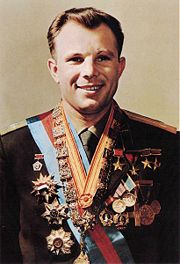
Post-Stalin Soviet Union
Joseph Stalin died on March 5, 1953. In the absence of an acceptable successor, the highest Communist Party officials opted to rule the Soviet Union jointly, although a struggle for power took place behind the facade of collective leadership. Nikita Khrushchev, who had won the power struggle by the mid-1950s, denounced Stalin's use of repression in 1956 and eased repressive controls over party and society known as de-Stalinization. At the same time, Soviet military force was used to suppress nationalistic uprisings in Hungary and Poland in 1956. During this period, the Soviet Union continued to realize scientific and technological pioneering exploits; to launch the first artificial satellite, Sputnik 1; a living dog, Laika; and later, the first human being, Yuri Gagarin, into Earth's orbit. Valentina Tereshkova was the first woman in space aboard Vostok 6 on 16 June 1963, and Alexey Leonov became the first person to walk in space on March 18 1965. Khrushchev's reforms in agriculture and administration, however, were generally unproductive, and foreign policy towards China and the United States suffered difficulties, including those that led to the Sino-Soviet split. Khrushchev was retired from power in 1964.
Following the ousting of Khrushchev, another period of rule by collective leadership ensued, lasting until Leonid Brezhnev established himself in the early 1970s as the preeminent figure in Soviet political life. Brezhnev presided over a period of Détente with the West while at the same time building up Soviet military strength; the arms buildup contributed to the demise of Détente in the late 1970s. Another contributing factor was the Soviet invasion of Afghanistan in December 1979.
Throughout the period, the Soviet Union maintained parity with or superiority to the United States in the areas of military numbers and technology, but this strained the economy. In contrast to the revolutionary spirit that accompanied the birth of the Soviet Union, the prevailing mood of the Soviet leadership at the time of Brezhnev's death in 1982 was one of aversion to change. The long period of Brezhnev's rule had come to be dubbed one of "standstill" (застой), with an aging and ossified top political leadership.
After some experimentation with economic reforms in the mid-1960s, the Soviet leadership reverted to established means of economic management. Industry showed slow but steady gains during the 1970s. Agricultural development continued, but could not keep up with the growing consumption and the USSR had to import food products like grain. Due to the low investment in consumer goods, the USSR was largely only able to export raw materials, notably oil, which made it vulnerable to global price shifts. Moreover, human welfare in the Soviet Union was keeping behind Western and socialist Central-European levels, after initially converging in the 1950s and 60's. Even in absolute measurements, Soviet citizens were becoming less healthy between the 1960s and 1985: the crude death rate climbed from 6.9 per 1,000 in 1964 to 10.3 in 1980.
Reforms of Gorbachev and dissolution
Two developments dominated the decade that followed: the increasingly apparent crumbling of the Soviet Union's economic and political structures, and the patchwork attempts at reforms to reverse that process. After the rapid succession of Yuri Andropov and Konstantin Chernenko, transitional figures with deep roots in Brezhnevite tradition, beginning in 1985 Mikhail Gorbachev made significant changes in the economy (see Perestroika, Glasnost) and the party leadership. His policy of glasnost freed public access to information after decades of heavy government censorship.
In the late 1980s, the constituent republics of the Soviet Union started legal moves towards or even declaration of sovereignty over their territories, citing Article 72 of the USSR Constitution, which stated that any constituent republic was free to secede. On April 7, 1990 a law was passed, that a republic could secede, if more than two thirds of that republic's residents vote for it on a referendum. Many held their first free elections in the Soviet era for their own national legislatures in 1990. Many of these legislatures proceeded to produce legislation contradicting the Union laws in what was known as " The War of Laws". In 1989, the Russian SFSR, which was then the largest constituent republic (with about half of the population) convened a newly elected Congress of People's Deputies. Boris Yeltsin was elected the chairman of the Congress. On June 12, 1990, the Congress declared Russia's sovereignty over its territory and proceeded to pass laws that attempted to supersede some of the USSR's laws. The period of legal uncertainty continued throughout 1991 as constituent republics slowly became de facto independent.
A referendum for the preservation of the USSR was held on March 17, 1991, with the majority of the population voting for preservation of the Union in nine out of fifteen republics. The referendum gave Gorbachev a minor boost, and, in the summer of 1991, the New Union Treaty was designed and agreed upon by eight republics which would have turned the Soviet Union into a much looser federation.
The signing of the treaty, however, was interrupted by the August Coup—an attempted coup d'état against Gorbachev by hardline Marxist members of the government, who sought to reverse Gorbachev's reforms and reassert the central government's control over the republics. After the coup collapsed, Yeltsin came out as a hero while Gorbachev's power was effectively ended. The balance of power tipped significantly towards the republics. In August 1991, Latvia and Estonia immediately declared restoration of full independence (following Lithuania's 1990 example), while the other 12 republics continued discussing new, increasingly looser, models of the Union.
On December 8, 1991, the presidents of Russia, Ukraine and Belarus signed the Belavezha Accords which declared the Soviet Union dissolved and established the Commonwealth of Independent States (CIS) in its place. While doubts remained over the authority of the Belavezha Accords to dissolve the Union, on December 21, 1991, the representatives of all Soviet republics except Georgia, including those republics that had signed the Belavezha Accords, signed the Alma-Ata Protocol, which confirmed the dismemberment and consequential extinction of the USSR and restated the establishment of the CIS. The summit of Alma-Ata also agreed on several other practical measures consequential to the extinction of the Union. On December 25, 1991, Gorbachev yielded to the inevitable and resigned as the president of the USSR, declaring the office extinct. He turned the powers that until then were vested in the presidency over to Boris Yeltsin, president of Russia. The following day, the Supreme Soviet, the highest governmental body of the Soviet Union, recognized the collapse of the Soviet Union and dissolved itself. This is generally recognized as the official, final dissolution of the Soviet Union as a functioning state. Many organizations such as the Soviet Army and police forces continued to remain in place in the early months of 1992 but were slowly phased out and either withdrawn from or absorbed by the newly independent states.
Politics
The government of the Soviet Union administered the country's economy and society. It implemented decisions made by the leading political institution in the country, the Communist Party of the Soviet Union (CPSU).
In the late 1980s, the government appeared to have many characteristics in common with liberal democratic political systems. For instance, a constitution established all organizations of government and granted to citizens a series of political and civic rights. A legislative body, the Congress of People's Deputies, and its standing legislature, the Supreme Soviet, represented the principle of popular sovereignty. The Supreme Soviet, which had an elected chairman who functioned as head of state, oversaw the Council of Ministers, which acted as the executive branch of the government. The chairman of the Council of Ministers, whose selection was approved by the Supreme Soviet, functioned as head of government. A constitutionally based judicial branch of government included a court system, headed by the Supreme Court, that was responsible for overseeing the observance of Soviet law by government bodies. According to the 1977 Soviet Constitution, the government had a federal structure, permitting the republics some authority over policy implementation and offering the national minorities the appearance of participation in the management of their own affairs.
In practice, however, the government differed markedly from Western systems. In the late 1980s, the CPSU performed many functions that governments of other countries usually perform. For example, the party decided on the policy alternatives that the government ultimately implemented. The government merely ratified the party's decisions to lend them an aura of legitimacy. The CPSU used a variety of mechanisms to ensure that the government adhered to its policies. The party, using its nomenklatura authority, placed its loyalists in leadership positions throughout the government, where they were subject to the norms of democratic centralism. Party bodies closely monitored the actions of government ministries, agencies, and legislative organs.
The content of the Soviet Constitution differed in many ways from typical Western constitutions. It generally described existing political relationships, as determined by the CPSU, rather than prescribing an ideal set of political relationships. The Constitution was long and detailed, giving technical specifications for individual organs of government. The Constitution included political statements, such as foreign policy goals, and provided a theoretical definition of the state within the ideological framework of Marxism-Leninism. The CPSU leadership could radically change the constitution or remake it completely, as it did several times throughout its history.
The Council of Ministers acted as the executive body of the government. Its most important duties lay in the administration of the economy. The council was thoroughly under the control of the CPSU, and its chairman—the Soviet prime minister—was always a member of the Politburo. The council, which in 1989 included more than 100 members, was too large and unwieldy to act as a unified executive body. The council's Presidium, made up of the leading economic administrators and led by the chairman, exercised dominant power within the Council of Ministers.
According to the Constitution, as amended in 1988, the highest legislative body in the Soviet Union was the Congress of People's Deputies, which convened for the first time in May 1989. The main tasks of the congress were the election of the standing legislature, the Supreme Soviet, and the election of the chairman of the Supreme Soviet, who acted as head of state. Theoretically, the Congress of People's Deputies and the Supreme Soviet wielded enormous legislative power. In practice, however, the Congress of People's Deputies met infrequently and only to approve decisions made by the party, the Council of Ministers, and its own Supreme Soviet. The Supreme Soviet, the Presidium of the Supreme Soviet, the chairman of the Supreme Soviet, and the Council of Ministers had substantial authority to enact laws, decrees, resolutions, and orders binding on the population. The Congress of People's Deputies had the authority to ratify these decisions.
The judiciary was not independent. The Supreme Court supervised the lower courts and applied the law as established by the Constitution or as interpreted by the Supreme Soviet. The Constitutional Oversight Committee reviewed the constitutionality of laws and acts. The Soviet Union lacked an adversarial court procedure known to common law jurisdictions. Rather, Soviet law utilized the system derived from Roman law, where judge, procurator and defense attorney worked collaboratively to establish the truth.
The Soviet Union was a federal state made up of fifteen republics joined together in a theoretically voluntary union; it was this theoretical situation that formed the basis of the Byelorussian and Ukrainian SSRs' membership in the United Nations. In turn, a series of territorial units made up the republics. The republics also contained jurisdictions intended to protect the interests of national minorities. The republics had their own constitutions, which, along with the all-union Constitution, provide the theoretical division of power in the Soviet Union. All the republics except Russian SFSR had their own communist parties. In 1989, however, the CPSU and the central government retained all significant authority, setting policies that were executed by republic, provincial, oblast, and district governments.
Leaders of the Soviet Union
The de facto leader of the Soviet Union was the First/General Secretary of the CPSU. The head of government was considered the Premier, and the head of state was considered the chairman of the Presidium. The Soviet leader could also have one (or both) of these positions, along with the position of General Secretary of the party. The last leader of the Soviet Union was Mikhail Gorbachev, serving from 1985 until late December 1991.
- List of Soviet Premiers
- (Chairman of the Council of People's Commissars of the USSR (1923–1946); Chairman of the Council of Ministers of the USSR (1946–1990); Prime Minister of the USSR (1991))
- List of Soviet Heads of state
- (Chairman of the Central Executive Committee of the All-Russian Congress of Soviets (1917–1922); Chairman of the Central Executive Committee of the USSR (1922–1938); Chairman of the Presidium of the Supreme Soviet of the USSR (1938–1989); Chairman of the Supreme Soviet of the USSR (1989–1990); President of the Soviet Union (1990–1991))
Foreign relations
Once denied diplomatic recognition by the capitalist world, the Soviet Union had official relations with practically all nations of the world by the late 1940s. The Soviet Union also had progressed from being an outsider in international organizations and negotiations to being one of the arbiters of the world's fate after World War II. A member of the United Nations at its foundation in 1945, the Soviet Union became one of the five permanent members of the UN Security Council which gave it the right to veto any of its resolutions (see Soviet Union and the United Nations).
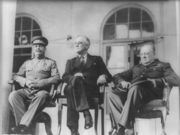
The Soviet Union emerged from World War II as one of the world's two superpowers, a position maintained for four decades through its hegemony in Eastern Europe (see Eastern Bloc), military strength, economic strength, aid to developing countries, and scientific research, especially into space technology and weaponry. The Soviet Union's growing influence abroad in the postwar years helped lead to a Communist system of states in Eastern Europe united by military and economic agreements. It overtook the British Empire as a global superpower, both in a military sense and its ability to expand its influence beyond its borders. The Council for Mutual Economic Assistance (COMECON / Comecon / CMEA / CAME), (Russian: Совет экономической взаимопомощи - СЭВ), 1949 – 1991, was an economic organization of communist states and a kind of Eastern Bloc equivalent to—but more geographically inclusive than—the European Economic Community. The military counterpart to the Comecon was the Warsaw Pact, though Comecon's membership was significantly wider.
The descriptive term Comecon was often applied to all multilateral activities involving members of the organization, rather than being restricted to the direct functions of Comecon and its organs. This usage was sometimes extended as well to bilateral relations among members, because in the system of socialist international economic relations, multilateral accords — typically of a general nature — tended to be implemented through a set of more detailed, bilateral agreements.
Established in 1949 the Soviet-dominated Council for Mutual Economic Assistance (COMECON) led by Moscow, served as a framework for cooperation among the planned economies of the Soviet Union, and, later, for trade and economic cooperation with the Third World. The military counterpart to the Comecon was the Warsaw Pact. The Soviet economy was also of major importance to Eastern Europe because of imports of vital natural resources from the USSR, such as natural gas.
Moscow considered Eastern Europe to be a buffer zone for the forward defense of its western borders and ensured its control of the region by transforming the East European countries into satellite states. Soviet troops intervened in the 1956 Hungarian Revolution and cited the Brezhnev Doctrine, the Soviet counterpart to the U.S. Johnson Doctrine and later Nixon Doctrine, and helped oust the Czechoslovak government in 1968, sometimes referred to as the Prague Spring.
In the late 1950s, a confrontation with China regarding the USSR's rapprochement with the West and what Mao perceived as Khrushchev's revisionism led to the Sino-Soviet split. This resulted in a break throughout the global Communist movement and Communist regimes in Albania and Cambodia choosing to ally with China in place of the USSR. For a time, war between the former allies appeared to be a possibility; while relations would cool during the 1970s, they would not return to normality until the Gorbachev era.
During the same period, a tense confrontation between the Soviet Union and the United States over the Soviet deployment of nuclear missiles in Cuba sparked the Cuban Missile Crisis in 1962.
The KGB (Committee for State Security) served in a fashion as the Soviet counterpart to both the Federal Bureau of Investigation and the Central Intelligence Agency in the U.S. It ran a massive network of informants throughout the Soviet Union, which was used to monitor violations in law. The foreign wing of the KGB was used to gather intelligence in countries around the globe. After the collapse of the Soviet Union, it was replaced in Russia by the SVR (Foreign Intelligence Service) and the FSB (Federal Security Service of the Russian Federation).
The KGB was not without substantial oversight. The GRU (Main Intelligence Directorate), not publicized by the Soviet Union until the end of the Soviet era during perestroika, was created by Lenin in 1918 and served both as a centralized handler of military intelligence and as an institutional check-and-balance for the otherwise relatively unrestricted power of the KGB. Effectively, it served to spy on the spies, and, not surprisingly, the KGB served a similar function with the GRU. As with the KGB, the GRU operated in nations around the world, particularly in Soviet bloc and satellite states. The GRU continues to operate in Russia today, with resources estimated by some to exceed those of the SVR .
In the 1970s, the Soviet Union achieved rough nuclear parity with the United States, and eventually overtook it. It perceived its own involvement as essential to the solution of any major international problem. Meanwhile, the Cold War gave way to Détente and a more complicated pattern of international relations in which the world was no longer clearly split into two clearly opposed blocs. Less powerful countries had more room to assert their independence, and the two superpowers were partially able to recognize their common interest in trying to check the further spread and proliferation of nuclear weapons (see SALT I, SALT II, Anti-Ballistic Missile Treaty).
By this time, the Soviet Union had concluded friendship and cooperation treaties with a number of states in the non-Communist world, especially among Third World and Non-Aligned Movement states like India and Egypt. Notwithstanding some ideological obstacles, Moscow advanced state interests by gaining military footholds in strategically important areas throughout the Third World. Furthermore, the Soviet Union continued to provide military aid for revolutionary movements in the Third World. For all these reasons, Soviet foreign policy was of major importance to the non-Communist world and helped determine the tenor of international relations.
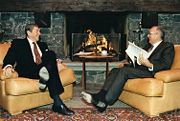
Although myriad bureaucracies were involved in the formation and execution of Soviet foreign policy, the major policy guidelines were determined by the Politburo of the Communist Party. The foremost objectives of Soviet foreign policy had been the maintenance and enhancement of national security and the maintenance of hegemony over Eastern Europe. Relations with the United States and Western Europe were also of major concern to Soviet foreign policy makers, and relations with individual Third World states were at least partly determined by the proximity of each state to the Soviet border and to Soviet estimates of its strategic significance.
After Mikhail Gorbachev succeeded Konstantin Chernenko as General Secretary of the CPSU in 1985, he introduced many changes in Soviet foreign policy and in the economy of the USSR. Gorbachev pursued conciliatory policies towards the West instead of maintaining the Cold War status quo. The Soviet Union ended its occupation of Afghanistan, signed strategic arms reduction treaties with the United States, and allowed its allies in Eastern Europe to determine their own affairs.
Following the dissolution of the Soviet Union on December 25, 1991, Russia was internationally recognised to be the legal successor to the Soviet state on the international stage. To that end, Russia voluntarily accepted all Soviet foreign debt, and claimed overseas Soviet properties as its own. To prevent subsequent disputes over Soviet property, "zero variant" agreements were proposed to ratify with newly independent states the status quo on the date of dissolution. (Ukraine is the last former Soviet republic not to have entered into such an agreement.) The end of the Soviet Union also raised questions about treaties it had signed, such as the Anti-Ballistic Missile Treaty; Russia has held the position that those treaties remain in force, and should be read as though Russia were the signatory.
Republics
The Soviet Union was a federation that consisted of Soviet Socialist Republics (SSR). The first Republics were established shortly after the October Revolution of 1917. At that time, republics were technically independent from one another but their governments acted in closely coordinated confederation, as directed by the CPSU leadership. In 1922, four Republics ( Russian SFSR, Ukrainian SSR, Belarusian SSR, and Transcaucasian SFSR) joined into the Soviet Union. Between 1922 and 1940, the number of Republics grew to sixteen. Some of the new Republics were formed from territories acquired, or reacquired by the Soviet Union, others by splitting existing Republics into several parts. The criteria for establishing new republics were as follows:
- to be located on the periphery of the Soviet Union so as to be able to exercise their right to secession;
- be economically strong enough to survive on their own upon secession; and
- be named after the dominant ethnic group which should consist of at least one million people.
The system remained almost unchanged after 1940. No new Republics were established. One republic, Karelo-Finnish SSR, was disbanded in 1956, and the territory formally became the Karelian Autonomous Soviet Socialist Republic (ASSR) within the Russian SFSR. The remaining 15 republics lasted until 1991. Even though Soviet Constitutions established the right for a republic to secede, it remained theoretical and very unlikely, given Soviet centralism, until the 1991 collapse of the Union. At that time, the republics became independent countries, with some still loosely organized under the heading Commonwealth of Independent States. Some republics had common history and geographical regions, and were referred by group names. These were Baltic Republics, Transcaucasian Republics, and Central Asian Republics.
| The Republics of the Soviet Union | ||||
|---|---|---|---|---|
| Flag | Republic | Capital | 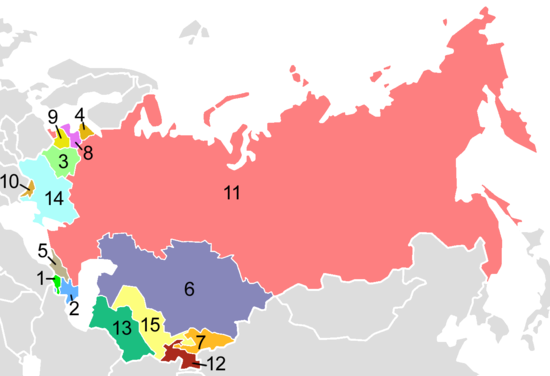 |
|
| 1 | Armenian SSR | Yerevan | ||
| 2 | Azerbaijan SSR | Baku | ||
| 3 | Byelorussian SSR | Minsk | ||
| 4 | Estonian SSR | Tallinn | ||
| 5 | Georgian SSR | Tbilisi | ||
| 6 | Kazakh SSR | Alma-Ata | ||
| 7 | Kirghiz SSR | Frunze | ||
| 8 | Latvian SSR | Riga | ||
| 9 | Lithuanian SSR | Vilnius | ||
| 10 | Moldavian SSR | Kishinev | ||
| 11 | Russian SFSR | Moscow | ||
| 12 | Tajik SSR | Dushanbe | ||
| 13 | Turkmen SSR | Ashgabat | ||
| 14 | Ukrainian SSR | Kiev | ||
| 15 | Uzbek SSR | Tashkent | ||
Economy
Prior to its dissolution the USSR had the second largest economy in the world after the United States. The economy of the Soviet Union was the modern world's first centrally planned economy. It was based on a system of state ownership and managed through Gosplan (the State Planning Commission), Gosbank (the State Bank) and the Gossnab (State Commission for Materials and Equipment Supply). The first major project of economic planning was the GOELRO plan, which was followed by a series of other Five-Year Plans. The emphasis was put on a very fast development of heavy industry and the nation became one of the world's top manufacturers of a large number of basic and heavy industrial products, but it lagged behind in the output of light industrial production and consumer durables.
Agriculture of the Soviet Union was organized into a system of collective farms ( kolkhozes) and state farms ( sovkhozes) but it was relatively unproductive. Crises in the agricultural sector reaped catastrophic consequences in the 1930s, when collectivization met widespread resistance from the kulaks, resulting in a bitter struggle of many peasants against the authorities, and famine, particularly in Ukraine (see Holodomor), but also in the Volga River area and Kazakhstan.
| Comparison between USSR and US economies (1989) according to 1990 CIA World Factbook |
||
|---|---|---|
| USSR | US | |
| GDP (1989 - millions $) | 2,659,500 | 5,233,300 |
| Population (July 1990) | 290,938,469 | 250,410,000 |
| GDP Per Capita ($) | 9,211 | 21,082 |
| Labour force (1989) | 152,300,000 | 125,557,000 |
As the Soviet economy grew more complex, it required more and more complex disaggregation of control figures (plan targets) and factory inputs. As it required more communication between the enterprises and the planning ministries, and as the number of enterprises, trusts, and ministries multiplied, the Soviet economy started stagnating. The Soviet economy was increasingly sluggish when it came to responding to change, adapting cost−saving technologies, and providing incentives at all levels to improve growth, productivity and efficiency. Most information in the Soviet economy flowed from the top down and economic planning was often done based on faulty or outdated information, particularly in sectors with large numbers of consumers. As a result, some goods tended to be underproduced, leading to shortages, while other goods were overproduced and accumulated in storage. Some factories developed a system of barter and either exchanged or shared raw materials and parts, while consumers developed a black market for goods that were particularly sought after but constantly underproduced.
Conceding the weaknesses of their past approaches in solving new problems, the leaders of the late 1980s, headed by Mikhail Gorbachev, were seeking to mold a program of economic reform to galvanize the economy. However, by 1990 the Soviet government had lost control over economic conditions. Government spending increased sharply as an increasing number of unprofitable enterprises required state support and consumer price subsidies to continue. Since the dissolution of the Soviet Union in 1991, almost all of the 15 former Soviet republics have dismantled their Soviet-style economies.
Geography
The Soviet Union occupied the eastern portion of the European continent and the northern portion of the Asian continent. Most of the country was north of 50° north latitude and covered a total area of approximately 22,402,200 square kilometres (8,649,500 sq mi). Due to the sheer size of the state, the climate varied greatly from subtropical and continental to subarctic and polar. 11% of the land was arable, 16% was meadows and pasture, 41% was forest and woodland, and 32% was declared "other" (including tundra).
The Soviet Union measured some 10,000 kilometres (6,200 mi) from Kaliningrad on the in the west to Ratmanova Island ( Big Diomede Island) in the Bering Strait, or roughly equivalent to the distance from Edinburgh, Scotland, west to Nome, Alaska. From the tip of the Taymyr Peninsula on the Arctic Ocean to the Central Asian town of Kushka near the Afghan border extended almost 5,000 kilometres (3,100 mi) of mostly rugged, inhospitable terrain. The east-west expanse of the continental United States would easily fit between the northern and southern borders of the Soviet Union at their extremities.
Population and society
The Soviet Union was one of the world's most ethnically diverse countries, with more than 200 distinct ethnic groups within its borders. The total population was estimated at 293 million in 1991, having been the 3rd most populous nation after China and India for decades. In the last years of the Soviet Union, the majority of the population were Russians (50.78%), followed by Ukrainians (15.45%) and Uzbeks (5.84%). Other ethnic groups included Armenians, Azerbaijanis, Belarusians, Estonians, Georgians, Kazakhs, Kyrgyz, Latvians, Lithuanians, Moldovans, Tajiks, and Turkmen as well as Abkhaz, Adyghes, Aleuts, Assyrians, Avars, Bashkirs, Bulgarians, Buryats, Chechens, Chinese, Chuvash, Cossacks, Evenks, Finns, Gagauz, Germans, Greeks, Hungarians, Ingushes, Inuit, Jews, Kalmyks, Karakalpaks, Karelians, Kets, Koreans, Lezgins, Maris, Mongols, Mordvins, Nenetses, Ossetians, Poles, Roma, Romanians, Rusyns, Tats, Tatars, Tuvans, Udmurts, Yakuts, and others. Mainly because of differences in birth rates among the Soviet nationalities, the share of the population that was Russian steadily declined in the post-World War II period.
Nationalities
The extensive multinational empire that the Bolsheviks inherited after their revolution was created by Tsarist expansion over some four centuries. Some nationality groups came into the empire voluntarily, others were brought in by force. Russians, Belarusians and Ukrainians shared close cultural ties while, generally, the other subjects of the empire shared little in common—culturally, religiously, or linguistically. More often than not, two or more diverse nationalities were co-located on the same territory. Therefore, national antagonisms built up over the years not only against the Russians but often between some of the subject nations as well.
For many years, Soviet leaders maintained that the underlying causes of conflict between nationalities of the Soviet Union had been eliminated and that the Soviet Union consisted of a family of nations living harmoniously together. In the 1920s and early 1930s, the government conducted a policy of korenizatsiya (indigenization) of local governments in an effort to recruit non-Russians into the new Soviet political institutions and to reduce the conflict between Russians and the minority nationalities. One area in which the Soviet leaders made concessions perhaps more out of necessity than out of conviction, was language policy. To increase literacy and mass education, the government encouraged the development and publication in many of the "national languages" of the minority groups. While Russian became a required subject of study in all Soviet schools in 1938, in the mainly non-Russian areas the chief language of instruction was the local language or languages. This practice led to widespread bilingualism in the educated population, though among smaller nationalities and among elements of the population that were heavily affected by the immigration of Russians, linguistic assimilation also was common, in which the members of a given non-Russian nationality lost facility in the historic language of their group.
The concessions granted national cultures and the limited autonomy tolerated in the union republics in the 1920s led to the development of national elites and a heightened sense of national identity. Subsequent repression and Russianization fostered resentment against domination by Moscow and promoted further growth of national consciousness. National feelings were also exacerbated in the Soviet multinational state by increased competition for resources, services, and jobs, and by the policy of the leaders in Moscow to move workers—mainly Russians—to the peripheral areas of the country, the homelands of non-Russian nationalities.
By the end of the 1980s, encouraged in part by Gorbachev's policy of glasnost, unofficial groups formed around a great many social, cultural, and political issues. In some non-Russian regions ostensible green movements or ecological movements were thinly disguised national movements in support of the protection of natural resources and the national patrimony generally from control by ministries in Moscow.
Religious groups
Although the Soviet Union was officially secular, it supported atheist ideology and suppressed religion, though according to various Soviet and Western sources, over one-third of the people in the Soviet Union professed religious belief. Christianity and Islam had the most believers. The state was separated from church by the Decree of Council of People's Comissars on January 23, 1918. Two-thirds of the Soviet population, however, had no religious beliefs. About half the people, including members of the CPSU and high-level government officials, professed atheism. Official figures on the number of religious believers in the Soviet Union were not available in 1989.
Christians belonged to various churches: Orthodox, which had the largest number of followers; Catholic; and Baptist and various other Protestant denominations.
Government persecution of Christianity continued unabated until the fall of the Communist government, with Stalin's reign the most repressive. Stalin is quoted as saying that "The Party cannot be neutral towards religion. It conducts an anti-religious struggle against any and all religious prejudices." In World War II, however, the repression against the Russian Orthodox Church temporarily ceased as it was perceived as "instrument of patriotic unity" in the war against "the western Teutonics". Repression against Russian Orthodox restarted from ca. 1946 onwards and more forcibly under Nikita Khrushchev. In 1914, before the revolution, there were over 54,000 churches, while during the early years of Stalin's reign that number was counted in the hundreds. By 1988, the number had decreased to roughly 7,000. Immediately following the fall of the Soviet government, churches were re-opening at a recorded rate of over thirty a week. Today, there are nearly 20,000.
Although there were many ethnic Jews in the Soviet Union, actual practice of Judaism was rare in Communist times. In 1928, Stalin created the Jewish Autonomous Oblast in the far east of what is now Russia to try to create a "Soviet Zion" for a proletarian Jewish culture to develop.
The overwhelming majority of the Islamic faithful were Sunni. The Azerbaijanis, who were Shiite, were one major exception. The largest groups of Muslims in the Soviet Union resided in the Central Asian republics (Kyrgyzstan, Tajikistan, Turkmenistan, and Uzbekistan) and Kazakhstan, though substantial numbers also resided in Central Russia (principally in Bashkiria and Tatarstan), in the North Caucasian part of Russia (Chechnya, Dagestan, and other autonomous republics) and in Transcaucasia (principally in Azerbaijan but also certain regions of Georgia).
Other religions, which were practiced by a relatively small number of believers, included Buddhism (mostly Vajrayana) and paganism (which was largely shamanic), a religion based on spiritualism. The role of religion in the daily lives of Soviet citizens thus varied greatly.


